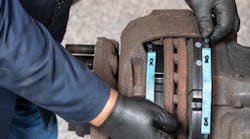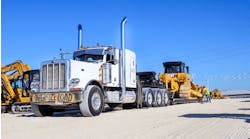If there’s one thing on commercial vehicles that operations and maintenance professionals need to understand, it’s braking systems. Not getting a truck to start rolling on time will cause delayed deliveries and missed work. Not getting it to stop will cause all that and a whole lot more, including property damage, injuries, and even death. Improper brake maintenance also will leave fleets and shops vulnerable to “nuclear” verdicts.
The good news is that fleets that keep up to date with the latest braking technology, as well as related preventive maintenance and inspections, shouldn’t lose any sleep over brake issues.
Drum or disc? Fleets weigh in
As a key element of safety, commercial vehicle stopping distances are codified in law. Specifically, FMVSS (Federal Motor Vehicle Safety Standard) 121 calls for air brake systems to fully stop tractor-trailers in no more than 250 ft. when loaded to their gross vehicle weight rating (GVWR) at 60 mph. This is true for commercial vehicles using either air disc brakes or S-cam drum brakes.
So, which type of brake can better help you meet these FMVSS standards?
According to Bendix Commercial Vehicle Systems, a 6x4 tractor-trailer going 60 mph takes 200 ft. to stop with air disc brakes and 225 ft. with drum brakes. An independent test of Bendix ADB22X air disc brakes completed on a test track by Pitt Ohio revealed that at 55 mph, these ADBs stopped 15 ft. earlier than drums.
“Fifteen feet is the length of a car,” noted Jeff Mercadante, VP of safety at Pitt Ohio, a perennial fleet safety award winner. “When you get up to 70 mph, you’re talking closer to 50 to 60 ft.”
Drum brakes, though, make up the majority of systems in trucking, as they initially cost less. ADBs, however, have gained market share in the last decade. In 2015, ADB adoption was about 15%, while in 2020 it doubled to 30%. ADBs have fewer parts for quicker servicing, which can lead to higher uptime and a better total cost of ownership. But that hardly settles the debate.
Terrance Wall, senior manager of maintenance technical support at Ryder, pointed out that for decades, S-cam type drum brake systems have been the “go-to” standard for medium- and heavy-duty trucks and tractors.
“Drum brakes are a consistent economical solution that provides common components across multiple vehicle platforms as well as weight classes,” he said. “And since the implementation of reduced stopping distance regulations in 2013, drum brake lining manufacturers have improved materials to meet or exceed the stopping distance requirements.”
“Although air disc brakes do have a slightly shorter stopping distance, drum brakes still easily meet the requirements,” Wall continued. “Air disc brake systems do have an advantage when brakes heat up and brake fade becomes more evident, but with a multi-vocational fleet, a uniform and economical option becomes the primary focus second only to safety.”
For Ryder, that is where drum brake systems have an advantage. When operating a wide variety of vehicles and with multiple repair locations, standard practices that include uniform training, tooling, and maintenance procedures are paramount to maximizing the useful life of brake components while maintaining the safety and cost effectiveness of the brake system.
Penske Truck Leasing, meanwhile, mostly specs ADBs. “To capitalize on their full benefit, however, both the tractor and trailer need to be equipped with air disc brakes,” noted Chris Hough, Penske’s VP of maintenance, design, and engineering.
Air disc brakes benefit the Penske fleet in several ways. In the area of safety, Hough noted, they provide shorter stopping distances and reduced brake fade. From a maintenance standpoint, there are fewer moving parts and grease points, and no need to measure brake stroke. Also, pad replacements are a relatively quick and simple process. Penske shops also are stocked with brake vendor-specific tools, along with hub handlers and various gauges to measure the remaining brake pad life and to inspect the rotor condition.
Hough also pointed out that ADBs have helped reduce the number of units placed out of service for brake stroke compliance issues during roadside inspections. “When it comes to ROI, there are some segments that are hard to measure,” he explained. “In general, we have found that ADBs provide a lower brake maintenance [cost per mile], provide our customers with improved stopping distances, and increase uptime.”
The advent of new technologies such as lane departure, electronic stability, and adaptive cruise control, which are now being integrated with ABS systems, also contribute a great deal to extending the life of foundation brake systems, he added. ADB systems also offer electronic pad wear sensors, which can provide data via telematics to assist in PM interval planning and procedures.
“All brake component manufacturers provide specific maintenance procedures to ensure optimal performance and life from these components,” Hough said. “By integrating these procedures into your brake maintenance program, coupled with the utilization of the correct tools, the maximum useful life at the most economical cost can be realized.”
“ADB systems provide benefits such as less time required to replace lining material and fewer components to lubricate,” Hough continued. “However, even with these benefits, ADB systems typically cost more to maintain and are difficult to standardize across a multi-vocational fleet without maintaining a larger inventory to accommodate the different spec and lining requirements.”
For example, some operations with repeated stop-and-go applications, such as refuse and inner city routes with multiple deliveries, can realize cost savings from shorter maintenance times and extended pad life when ADB systems are equipped with the proper friction material.
However, he cautioned that the ease of getting an accurate measurement of the lining material on both the front and rear of the rotor is consistently a drawback on currently designed ADB systems. This, in turn, typically leads to less than full utilization of the lining material if the pads are being changed prematurely.
“It is important to carefully analyze the duty cycle and operation of the fleet to determine the optimal type of brake system that makes economic sense but also provides the maximum useful life while retaining maintenance efficiency for your technicians,” Hough stated.
Avoiding OOS violations
No matter what types of brakes are employed by a fleet—and it may even be a mix of both on the same tractor-trailer—the driver and maintenance team must keep a close eye on their systems because the Commercial Vehicle Safety Alliance (CVSA) will be watching.
Unfortunately, not all fleets do. In the 2022 CVSA International Roadcheck commercial motor vehicle inspection and enforcement initiative, brake system issues resulted in the largest percentage of violations: 25.2% in the U.S., Canada, and Mexico combined. In fact, brakes were the top reason for out-of-service violations in both the U.S. (24%) and Canada (38%), and 26.1% of violations were second only to tires in Mexico.
According to FMCSA’s Motor Carrier Management Information System, common out-of-service violations for all of 2022 included: brake hose or tubing chafing and/or kinking (Violation code 393.45B2), inoperative/defective brakes (393.48A), brakes out of service (396.3A1BOS), and missing or defective parking brake system (393.95B).
It’s impossible to know all the different variables and events that led to all of these violations. What is known is that the last line of defense, the driver, likely missed something on their pre-trip inspection.
“Considering that a high percentage of violations for brake issues are air leaks and chafed air hoses, a big part—but not all, of course—of these could be avoided with a good pre-trip inspection,” noted Keith DiRuscia, manager of fleet maintenance at Pitt Ohio. “We still keep our preventive maintenance intervals at a point where we catch most brake thickness and cracked lining at the shop level.”
Drivers are the last line of defense, though, and former Washington State Patrol officer Fred Fakkema, currently VP of safety and compliance at Zonar Systems, offered some tips to help drivers avoid these types of brake violations.
“While conducting pre-trip inspections, listen for leaks and look at the hoses and valves,” he said. “It’s very easy to see chafing and check the connections. A visual check of slack adjusters and wheel ends is also important during the pre-trip. Many drivers believe that since there are automatic adjusters, there is no reason to look. But they are still mechanical and need to be maintained.”
Fakkema urged that drivers not get complacent. Issues such as pressure loss or an inoperable parking brake should be discovered during a proper pre-trip. It is important that fleets are proactive at all times.
“Once a fleet realizes they may have an issue with brake violations, it may be too late, and they will have already received numerous roadside inspections with brake violations,” he said. “A fleet should always have pre-trip inspections and identify brake violations in their ongoing in-service training. The training and reinforcement of these issues are vital—not only for the safety of the driver but also for all motorists on the road.”
Fakkema noted that seven of the top 20 CVSA violations were for brakes.
“If you stop and think about that, the mechanism that stops an 80,000-lb. truck is among the most noted violations,” he explained. “That alone should encourage the driver to do a proper pre-trip inspection to get in that safety mindset before leaving the yard.”
This article originally appeared in its entirety on Fleet Maintenance.





